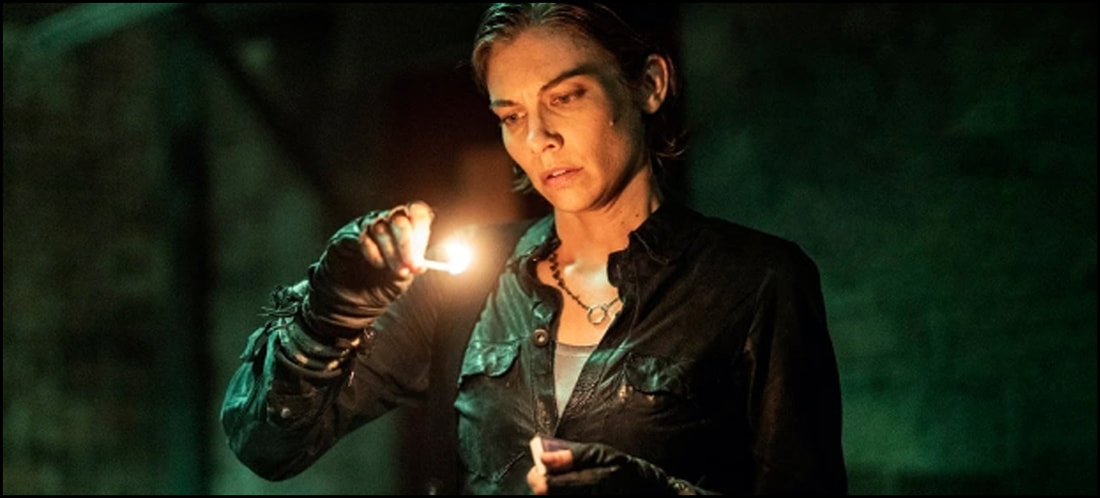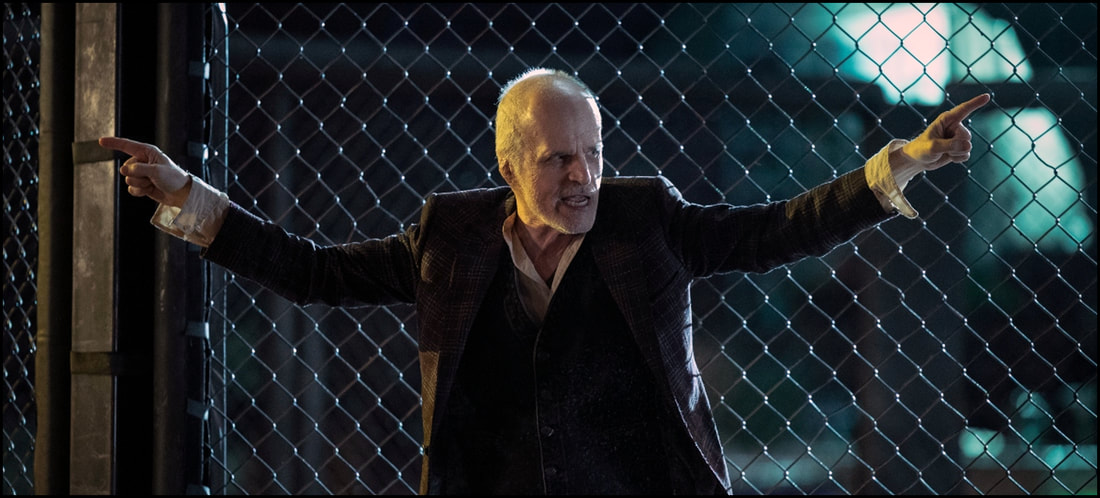From the show’s IMDB.com page citation:
“Dark instincts reveal themselves as Maggie and Negan for a strategy; Armstrong is tested; Ginny embarks on a daring journey.”
Sigh.
Yes, folks, that’s an actual sigh.
I know I sigh a lot these days, but it’s really grown pretty tiresome for having to spend so much time recounting just how much bad writing would seem to have proliferated so many of fandom’s greater and greatest franchises. Star Wars has suffered from it, as have a good deal of the Marvel properties on streaming or the multiplexes. Don’t get me started on Star Trek: Discovery or the general state of the Gene Roddenberry property, or I might just cry. The latest Indiana Jones tentpole feature is replete with an awful lot of undercooked ideas and even more than a few half-baked assumptions about characters, careers, and circumstances.
Like I said: sigh.
Yes, I realize some who pen and speak criticism online regarding The Walking Dead have said the show has waded through a mountain of it for a few seasons, but – in some frank honesty here – I just didn’t see it. This isn’t in any way to malign those who did or even suggest that perhaps it was there and I missed it: rather, it’s a confession that I had a fundamental disagreement with those who do what I do, and I interpreted some of the show’s developments as being an organic attempt to try something different, to try to accomplish more with less. It may not have been fresh. It may not have been effective. But I saw it as a concerted effort to turn the show in a different direction, and this happens from time-to-time when casts evolve, screenwriters come-and-go, and even showrunners and networks ask for a bit of reinvention.
But – damn – Dead City is truly reeking of something greater than the decomposing Walking Dead these days, and it would appear that no effort is being expended to change the narrative. In fact, it looks like “People Are A Resource” (Season 1, Episode 3) is doubling-down on stupid, and they’re now pushing creative boundaries with bad puns. (Without spoiling it, let’s just say that viewers should be watching for ‘people are a resource’ to have a double meaning.)
Yikes!
In my own defense, however, I will point out that I haven’t been all that enamored with Dead City since its premiere. (Interested readers can find my reviews of Episode 1 and Episode 2 respectively.) While “Who’s There?” did offer me a brief return-to-form (thanks, Negan, for what might be the series’ highlight) and maybe even a fleeting hope that the ship would be sailing in a favorable direction, “People Are A Resource” rather quickly squashed out those creative embers by resorting to the franchise’s long and tired fascination with the usual suspects: flashbacks, sidebars, and long, steely looks.
Seriously? Is there nothing more in this tank?
The installment opens up with yet more screen time dedicated to Ginny – Negan’s surrogate daughter – who has now – with apparently no difficulty whatsoever – arrived at the shores opposite the infamous New York City. Before you know it, why, she’s gone and done what Maggie led us to believe early on was downright unthinkable: wasn’t it implied, at the very least, that getting across to Manhattan Island was a difficult prospect? Here, Ginny experienced absolutely no challenges, and – in the last frames of the episode – we’re shown that she’s already made it (in a single episode) damn near as far as our show’s headliners have … so what in the Holy Hell was all of the fuss about after all? Perhaps the showrunners and producers could’ve saved themselves some behind-the-scenes money by jettisoning Jeffrey Dean Morgan’s salary and instead made the show about Maggie and Ginny’s quest to recover Maggie’s abducted son.
(Relax, haters: that’s what old dogs like me call a joke. I likely wouldn’t have tuned in to a Dead-themed Thelma and Louise, nor would much of fandom.)
The remainder of the episode again explores Negan and Maggie’s still tenuous relationship (which it’s always been), both with themselves and these islanders, as well as expands upon New Babylon Marshal Armstrong’s plight as he’s been abducted by ‘The Croat’ our dynamic duo are trying to reach. So … are I suggest that maybe just being captured would’ve been a better course of action after all for Maggie and Negan? Wouldn’t that, too, have taken them exactly where they wanted to go? It certainly would’ve saved viewers these flashbacks and sidebars which only serve to kill whatever forward progress Dead City has developed.
I’m not trying to pick on the fallen law officer, but Armstrong – like Ginny – just isn’t all that interesting a character to begin with. At this point, he could have any backstory – he could be any number of disposal or displaceable faces – because he’s never been fully vetted by the viewing audiences. We have no attachment to him and his adventure, so it’s an entirely meaningless series of exchanges only meant to show what life is like for ‘The Croat’ and his people. But couldn’t we have been shown this had Maggie and Negan been captured? Wouldn’t that have been more relevant? Wouldn’t that also give our supposed series heroes the opportunity to show us exactly why they’ve been blessed with this spin-off? Up to now, they’re basically just standing still or shooting knowing glances at one another, and here I tuned in thinking I was going to see them back in action.
I’ve no idea how much Dead City costs AMC, and I’m not really in any position to determine whether or not their investment could’ve been better spent. My point is that spin-offs are never easy sells to begin with, and what endears us to players that do get the opportunity to move along in new iterations may not be what transpires in the expanded universe. Aboard The Walking Dead, Maggie was all about her relationships with others as well as the exalted position she had earned amongst them there; in Dead City, she’s spent a lot of time just glaring at people, places, and things. She’s constantly angry or borderline teary, never showing us the resolve that fueled her actions in the previous show. Also aboard TWD, Negan, too, had lost a bit of his violent edge but had gained a greater understanding of the fact that maybe – just maybe – he had something more to offer the survivors of the human race other than an obvious lust and fascination with killing, doing mankind’s dirtiest work ever. Here, like Maggie, he’s fixing his eyes on stuff, grimacing for the camera, or nodding quietly, never showing only an inkling of what made him worth watching in the first place.
Complaints aside, there are threads that suggest that perhaps the show’s writers may still have a little ‘something something’ in their bag of tricks they’re trying to conceal in the all-too-brief six-episode run/arc.
I’ve often argued that there can be nuggets of good writing wrapped up within the bad, and that’s possibly no different than what audiences might be seeing here. Often times, creators have a knack for crafting solid beginnings, fabulous little filler scenes (Negan’s return to form in Episode 2’s closing moments), or bigger-than-life finales or cliffhangers; but they tend to lose focus on putting as much effort into making that line between points A and B and C as memorable as they could, would, and should be. In the 1980’s, it was somewhat famously reported that certain big name marquee talents (i.e. Arnold Schwarzenegger or Sylvester Stallone) often employed their own ghost writers to board each and every new project, review the current draft of the shooting script, and inject said tale with some of these characteristic big ticket plot points or even great one-liners. Like athletes, writers do have their own set of strengths – things they’re uniquely good at – and a room filled with screenwriters might achieve weaker results because of the old ‘too many cooks spoil the meal’ adage.
For example, both central characters Maggie and Negan are clearly seeking a kind of shared redemption here. Maggie and son Hershel didn’t part on the best of terms before his abduction, so she’s wanting to make things right and continue that ongoing challenge that parenting can be while there’s still a chance. And even an immeasurable and violent heavy like Negan is personally troubled that – when he had a chance in his past to rid the world of ‘The Croat’ – he failed to make even his world a better place. The scribes have found ways to dangle these ideas in each of the program’s three episodes, and – while such hints have been somewhat obvious and repetitive – there’s always reason to hope that such flirtation might eventually bode some wonderful rewards. In that respect, only time will tell.
Essentially, I think fans were promised something greater if not different with this show other than a TV-grade version of John Carpenter’s Escape From New York (1981), this one with literal zombies replacing the figurative zombified criminal establishment incarcerated within what was left of the Big Apple. Still, the coincidences aren’t looking so coincidental at this point in Dead City’s run. Isolated big city? Check! Subterranean cannibals? Check. Break in, locate the missing, and get back out? Check! And – for that matter – the similarities don’t stop there, but I’ll happily leave it at that as I think my point has been made. We were promised something different, but we’re getting more of the same.
Were I an investor, I’d be asking AMC for my money back.
In the interests of fairness, I’m thrilled to disclose that – like so many of you – I’ve simply recorded and watched The Walking Dead: Dead City’s “People Are A Resource” (S01E03) as it aired on AMC, so I’m beholden to no one to provide a review other than myself.
-- EZ



 RSS Feed
RSS Feed